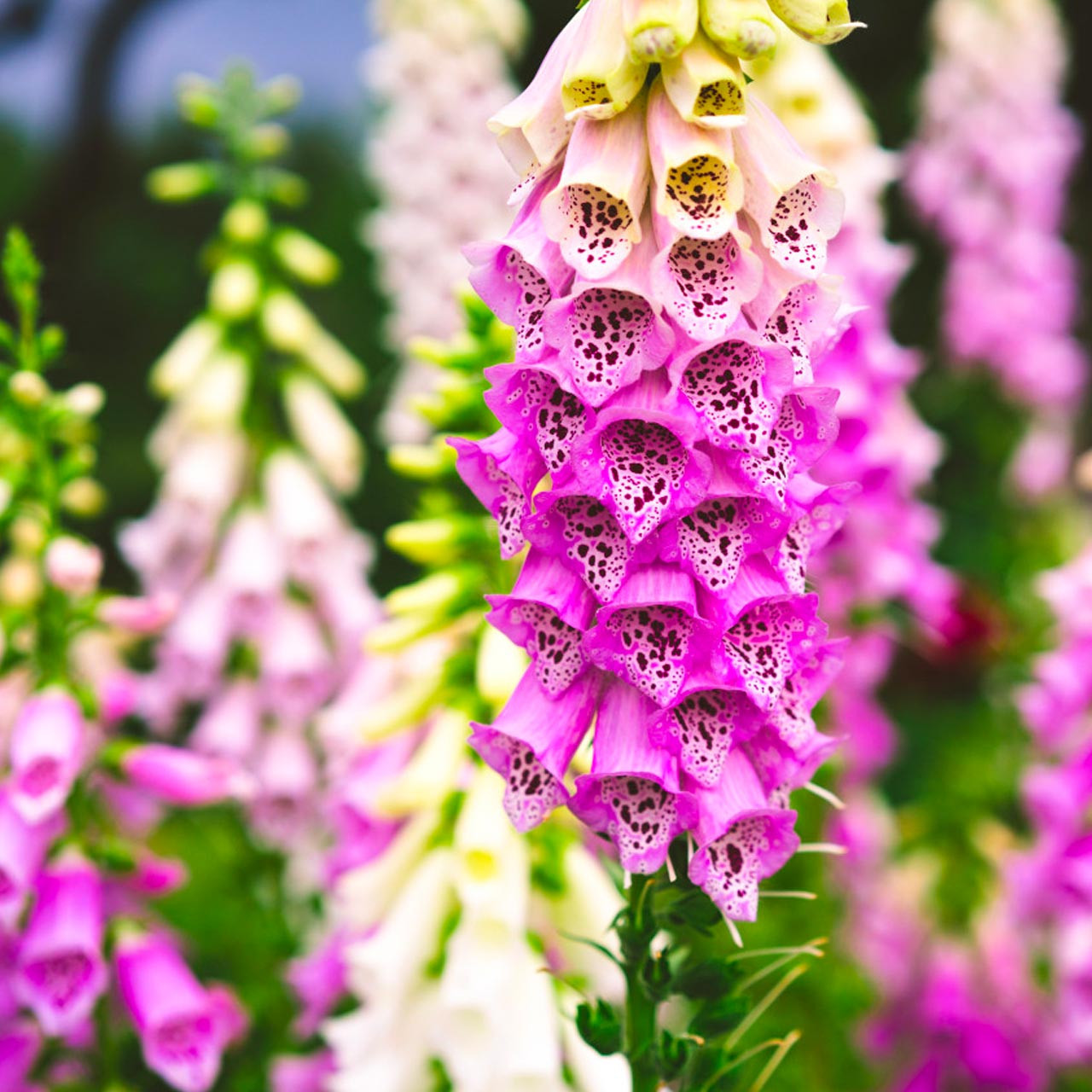Few plants command attention like the majestic foxglove, with its tall, spire-like stems lined with tubular, bell-shaped flowers. Often found adding height and drama to cottage gardens and woodland edges, foxglove blooms in a spectrum of purples, pinks, whites, and yellows, with many varieties displaying spotted throats that draw in bees and hummingbirds.
While captivating, foxglove carries a warning—all parts of the plant are toxic if ingested, including to pets and humans. Still, for the informed and careful gardener, foxglove offers architectural beauty and wildlife value.

Portrait of the Foxglove
Foxglove (Digitalis) belongs to the Plantaginaceae family. Though a short-lived perennial or biennial in many climates, it reseeds readily, ensuring its return each season. It’s native to Europe but has naturalized in many temperate regions.
- Type: Biennial or short-lived perennial
- Family: Plantaginaceae
- Common species: Digitalis purpurea, Digitalis grandiflora, Digitalis lutea
Foliage and Form
Foxglove forms a basal rosette of soft, downy leaves in its first year. In its second year, it sends up towering flowering spikes that can reach 1.5–2 meters (5–6.5 ft) in height.
- Height: 90–200 cm (3–6.5 ft)
- Spread: 30–60 cm (1–2 ft)
- Growth Habit: Upright flowering spikes with dense foliage at base
Blooms and Fragrance
The tubular flowers are borne densely along tall spikes, blooming from bottom to top. The insides often display speckles or patterns that act as nectar guides for pollinators.
- Bloom Time: Late spring to mid-summer
- Color: Purple, white, pink, yellow, peach
- Fragrance: Mild to none; mainly visual appeal
The Right Time to Plant and Care for Foxglove
Foxglove is biennial, meaning it produces foliage the first year and flowers in the second. However, staggered planting or self-seeding allows for annual blooms in established gardens. Deadheading spent flower stalks can extend blooming or encourage rebloom.
| Month | Planting | Flowering | Pruning (Deadheading) |
|---|---|---|---|
| January | ❌ | ❌ | ❌ |
| February | ❌ | ❌ | ❌ |
| March | ✅ (indoors or seed trays) | ❌ | ❌ |
| April | ✅ | ❌ | ❌ |
| May | ✅ | ❌ (young plants only) | ❌ |
| June | ✅ | ✅ (2nd-year plants) | ✅ |
| July | ❌ | ✅ | ✅ |
| August | ❌ | ✅ | ✅ |
| September | ✅ (fall sowing) | ❌ | ✅ |
| October | ✅ (in warm zones) | ❌ | ✅ (cut back stems) |
| November | ❌ | ❌ | ❌ |
| December | ❌ | ❌ | ❌ |
✅ = Recommended ❌ = Not advised
Ideal Watering, Sunlight, and Environment for Foxglove
Watering
- Moderate watering—keep soil evenly moist but not soggy.
- Avoid overhead watering to prevent fungal leaf issues.
Sunlight
- Thrives in partial shade but tolerates full sun in cooler climates.
- Ideal in dappled light or woodland edges.
Indoor vs Outdoor
- Primarily an outdoor plant, not suitable as a houseplant.
- Great for woodland gardens, shaded borders, and naturalized areas.
Temperature
- Hardy in USDA zones 4–9.
- Prefers cooler summers; may need some afternoon shade in hot climates.
Ideal Soil Conditions for Growing Foxglove
| Soil Feature | Optimal Condition | Why It Matters |
|---|---|---|
| Soil Type | Rich, loamy, well-drained | Prevents waterlogging and supports healthy root growth |
| Texture | Fine to medium | Holds moisture while allowing drainage |
| Drainage | Good | Prevents crown and root rot |
| Moisture | Moist but not waterlogged | Even moisture promotes consistent growth |
| Soil pH | Slightly acidic to neutral (6.0–7.0) | Aids in nutrient availability |
| Fertility | Moderate | Too much nitrogen can lead to lush leaves, fewer flowers |
Common Problems & Solutions
| Issue 🐾 | Symptoms 🔍 | Solutions 🛠️ |
|---|---|---|
| Aphids 🐜 | Curling leaves, sticky residue | Use insecticidal soap or neem oil |
| Powdery Mildew 🌫️ | White coating on leaves | Improve air circulation, avoid wetting leaves |
| Root Rot 💧 | Yellowing leaves, mushy roots | Ensure proper drainage and don’t overwater |
| Rust Fungi 🍂 | Orange pustules on leaf undersides | Remove affected leaves, apply fungicide |
| Poor Flowering 🌱 | No blooms in 2nd year | Plant may still be in 1st year—allow for full biennial cycle |
Foxglove brings bold, vertical interest and classic charm to the garden, along with ecological benefits. While its toxicity requires caution, its rewards in bloom and beauty are undeniable.